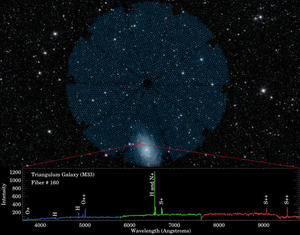UCI astronomers help implement new sky surveying tool to shed light on dark energy

DESI’s 5,000 spectroscopic “eyes” can cover an area of sky about 38 times larger than can the full moon, as seen in this overlay of DESI’s focal plane on the night sky (top). Each robotically controlled eye can fix a fiber-optic cable on a single object to gather its light. (The red circle marks the location of a single positioner.) The gathered light collected from a small region in the Triangulum galaxy (bottom) by a single fiber-optic cable is split into a spectrum that reveals the fingerprints of the elements present in the galaxy and aids in gauging their distance. The test spectrum shown here was collected by DESI on Oct. 22. Dustin Lang, Aaron Meisner, DESI Collaboration / Imagine Sky Viewer; NASA/JPL-Caltech
Mounted on a telescope at Kitt Peak National Observatory near Tucson, Arizona, DESI was designed to explore the mystery of dark energy, which is responsible for the accelerating expansion of the universe. Implementation of the tool was long anticipated by five UCI astronomers, members of a 500-person international team responsible for the development and activation of DESI. The UCI players designed a subcomponent to monitor the varying brightness of the night sky to ensure that each image captured by the instrument is properly exposed. “This is the culmination of six years of design, research and development efforts at UCI to be ready for this moment,” said David Kirkby, UCI professor of physics & astronomy. “We are all excited to start building and analyzing an unprecedented 3D map of the universe.” His UCI collaborators are graduate students Bela Abolfathi, Abby Bault, Dylan Green and Noble Kennamer. DESI’s components are designed to automatically target preselected sets of galaxies, gather their light, and then split it into narrow bands of color to precisely map galaxies’ distance from Earth and gauge how much the universe expanded as this light traveled to our planet. In ideal conditions, DESI can cycle through a new set of 5,000 galaxies every 20 minutes. The operation was the latest milestone toward the final testing of DESI and planned formal start of observations in early 2020.
